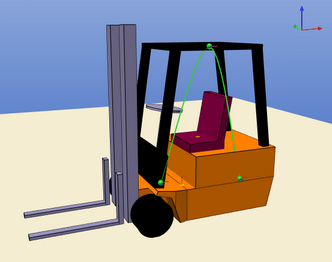In this task, the human model moves into a vehicle / a car body. Distinction is made whether the human model will sit inside the car body or whether it will kneel down.
Subordinate tasks:
Move foot to target, Slide to target
Parameter |
Type |
Mand. |
Meaning |
|---|---|---|---|
Port of entry |
Path |
yes |
A path parameter used for the representation of the entrance / door of the car body. At least three path points must be selected and at least two points with a greater distance must be put onto the door sill. One point should represent the maximum height. This height is used to determine the degree of inclination of the upper body while entering. |
Target for hip |
Position & orientation |
yes |
A coordinate parameter defining the target point and the viewing direction of the human model at the target place. |
Entrance target |
Position |
yes |
A coordinate parameter determining the target point for the foot while entering the car body. For sitting down, a point in the leg room should be selected and, for kneeling down, a point on the door sill should be selected. |
Automatic walking |
Checkbox |
yes |
A decision parameter determining whether the human model will automatically walk to the indicated target point / target object. |
Target for left foot |
Position |
no |
A coordinate parameter defining the target point / the final position for the left foot. This parameter is only used for sitting down. Otherwise, the parameter does not have any impact. |
Target for right foot |
Position |
no |
A coordinate parameter defining the target point / the final position for the right foot. This parameter is only used for sitting down. Otherwise, the parameter does not have any impact. |
Maximum permissible height of the head |
Position |
no |
A coordinate parameter whose Z value defines the maximum admissible height for the head within the car. During this process, the human model inclines its upper body / its hip in order to avoid an exceedance of the height limit. If the parameter is set too low, it will be ignored and the maximum height of the entrance is used. |
Kneel |
Checkbox |
no |
A decision parameter determining whether the human model will sit inside the car or kneel down inside the car body. This parameter is not activated. The human model sits if this parameter is not activated. This parameter has an influence on the use and mode of action of the other parameters. |
Backrest available |
Checkbox |
no |
A decision parameter determining whether a backrest is available or not. This parameter has an influence on the ergonomics evaluation. |
Headrest available |
Chekbox |
no |
A decision parameter determining whether a support for the head is possible or not. This parameter is only relevant to ergonomics and does not have any impact on the motion performed. |
Use entrance point as temporary floor height |
Checkbox |
no |
A decision parameter determining whether the entrance point will be used as temporary floor height. In case of activation, the height indication of the entrance point is used as standard floor height for the human model until the exit. |
iIt is useful to create a floor object for the car body in the form of a simple cuboid. In some tasks in ema, an automatic height correction of the human model to floor objects is integrated which might lead to unwanted effects during simulation, if this additional floor object is not available. This floor object should be marked in ema. iFor further notes, see task Get off the vehicle in the chapter Performance library / Body movements / Get off the vehicle. |

Figure 198: Preferred definition of port of entry
In the figure Preferred definition of port of entry a preferred definition of port of entry is shown. From the path, two lower points are considered to compute the entry line that need to be crossed and the topmost point for constraining the head height.